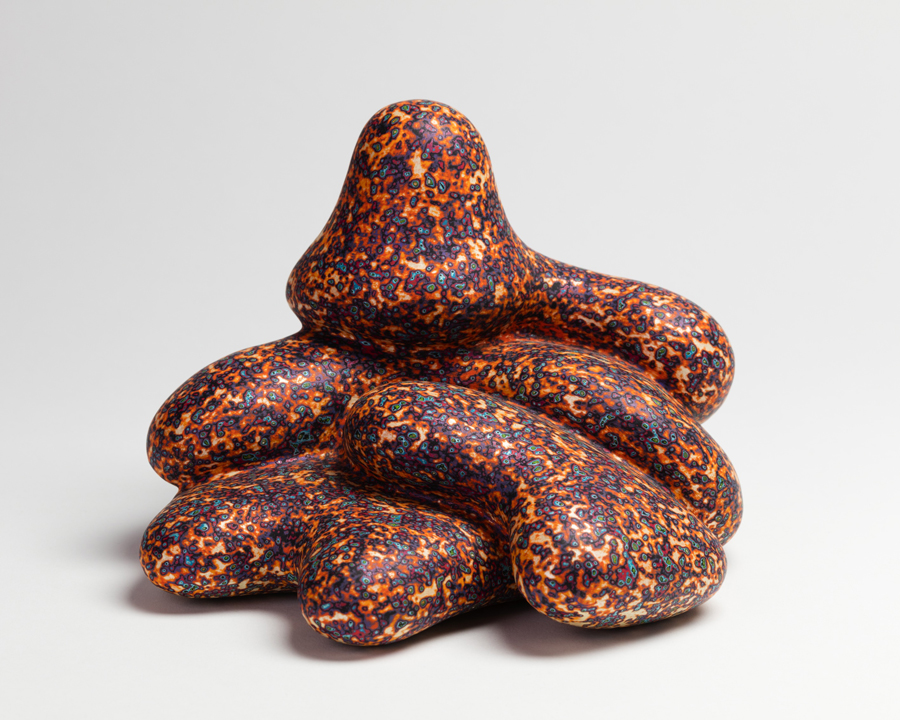Ken Price
Hauser & Wirth, London, UK
Hauser & Wirth, London, UK

When Ken Price’s psychedelic ‘snail cups’ were shown at London’s Kasmin gallery in 1968, the ceramics of Britain were, for the most part, immured in a world of brown and off-brown. It is as much the fault of Bernard Leach’s beige philosophy of reduction-fired stoneware as it is a horrible accident of British geology that Price’s show was the first time many artists and potters in this country saw that vivid Technicolor was easily possible in the kiln; and, if it wasn’t, gloss paint might suffice. The production of new and exciting finishes (especially those achieved with car paint) echoed for the young artists who saw them something of the hypertrophied, polychrome world of the American West Coast transmitted by texts such as Tom Wolfe’s The Kandy-Kolored Tangerine-Flake Streamline Baby (1965).

Hauser & Wirth’s semi-retrospective of Price’s sculptures and drawings, made between 1959 and 2006, is similarly kaleidoscopic in scope – and, for us in London, long overdue. In one of the gallery’s two Savile Row spaces, large works spanning Price’s entire career are placed on a grid of pulpit-like plinths. The effect is one that allows for both single-perspective reverence, but also for an almost haptic exploration of the works from all sides. This is extremely successful at humanizing the works, arranged as they are at eye level. It is also useful for the direct comparison of early ‘pure’ ceramic works, such as Avocado Mountain (1959), with the silvery, jet-age biomorphism of Ghosted (1998), by which point Price was mainly exploiting iridescent paintwork techniques borrowed from the world of custom cars.
The second gallery is more difficult to navigate. It is an extremely generous display, presenting upwards of 100 works, and it is wonderful to see so many of Price’s smaller sculptures alongside his more esoteric drawings (depicting swimming cups, for instance, or women bathing in lava). However, many strands of his work are only half-exposed within the selection, with the overall effect that the show resembles an estate sale. I would have liked, for example, to have seen a proper revisiting of Price’s vastly misunderstood ‘Happy’s Curios’ (1972–78) series. There are lots of these pieces on display, but they are isolated rather than in the mise-en-scène dressers that were their original display structures and are vital for understanding Price’s incisive sense of composition and combination.

Price was clearly fastidious about the presentation of his work and I wonder whether he would have appreciated a wall-sized display of his sketches for ceramics here, some of them defaced by the routine graffiti of shopping lists and debts. (Though the sketches are complete – and beautiful – Price was hesitant to show even his more erotic paintings and drawings ‘proper’ during his lifetime.) It seems an unnecessary legend to what is otherwise a thoughtful and ecstatic overview of a career.
Price once explained that the purpose of his work was ‘strictly for pleasure’, a sentiment that happily abounds in this show. If the sheer scale and multifariousness of the exhibition equates Price’s statement with a prelapsarian joy of making, then a closer reading of certain forms perhaps suggests something more expansive: an understanding of pleasure as socially productive, rather than merely self-indulgent. Ceramic material is difficult to scale up with elegance and the ‘bigness’ of a piece must often be made to emanate from mechanisms perhaps more commonly found in jewellery and other close work. It is this closeness, this discretion, that shines out of Price’s most successful pieces. Lumpen cups plagued by snails, jewelled insect nests made of colour: these are not items related to the hermetic pleasure of the craft potter, but are a wishful incantation of an Elysian society bent primarily on whimsical hedonism and a sophisticated materiality.

Price’s work often creams the myth-world of American motor culture, cosmic chintz and surfer philosophy, but it also draws foggily on historical locales of making such as the ‘Floating Worlds’ of Edo-period Japan. The artist wrote specifically of his appreciation of Bizen ware and other ceramics of the Momoyama period (1573–1615 CE), calling them ‘the ultimate achievement in the history of pottery’. The culture of that era was defined by the philosophical search for enjoyment and gratification, made manifest in pieces of 16th-century psychedelia such as Tabi-makura, a type of warped, casually glazed` flower vase, the name of which translates as ‘portable pillow’.
These were the voluptuous and thoughtful luxury products of a society enjoying a century of peace, and it is in channeling this idyll that Price’s life’s work – and this exhibition – is most successful. At its best, it is not evocative of ejaculatory jouissance, but of living slowly, heavily and generously in a state of productive happiness. The best sort.
























